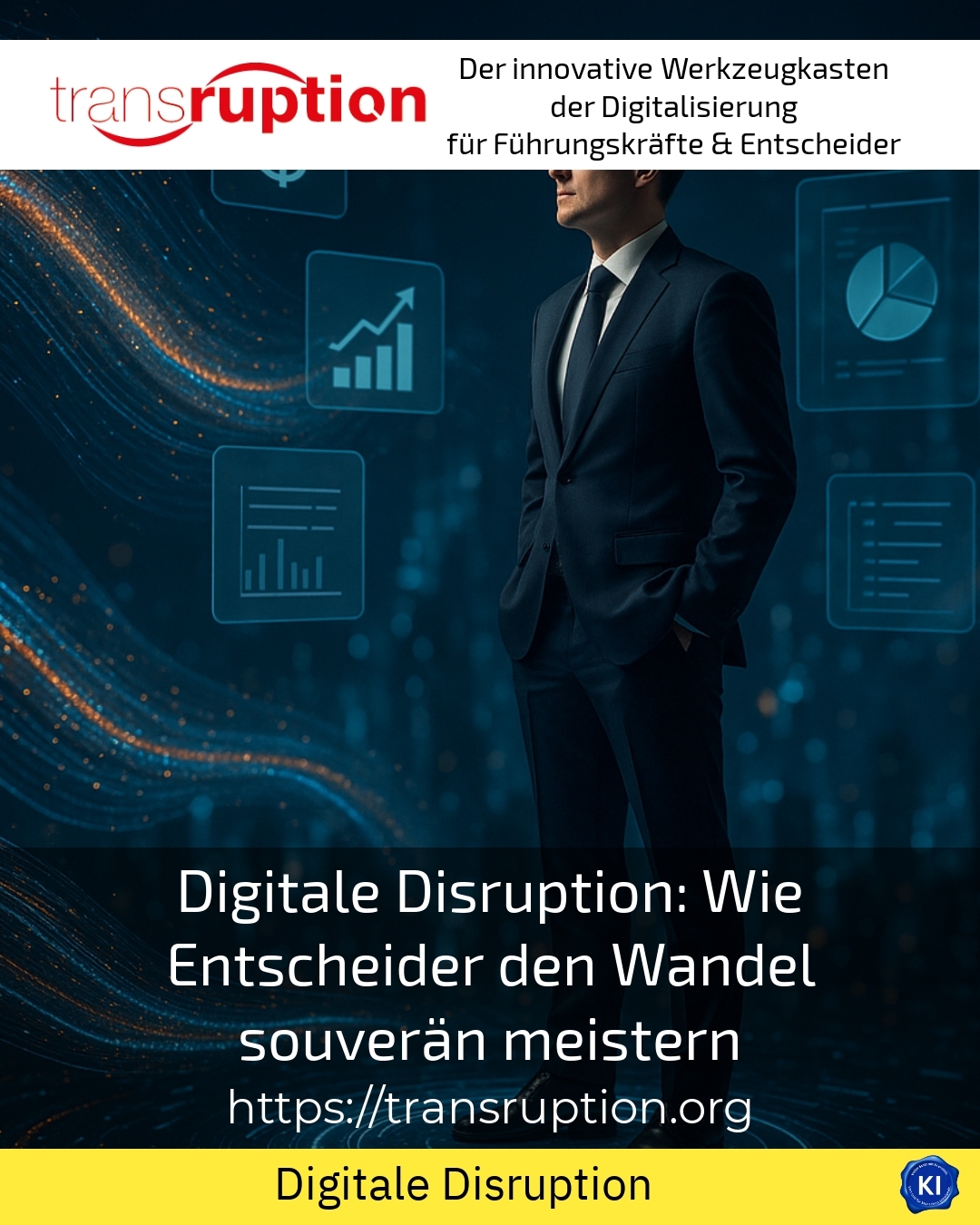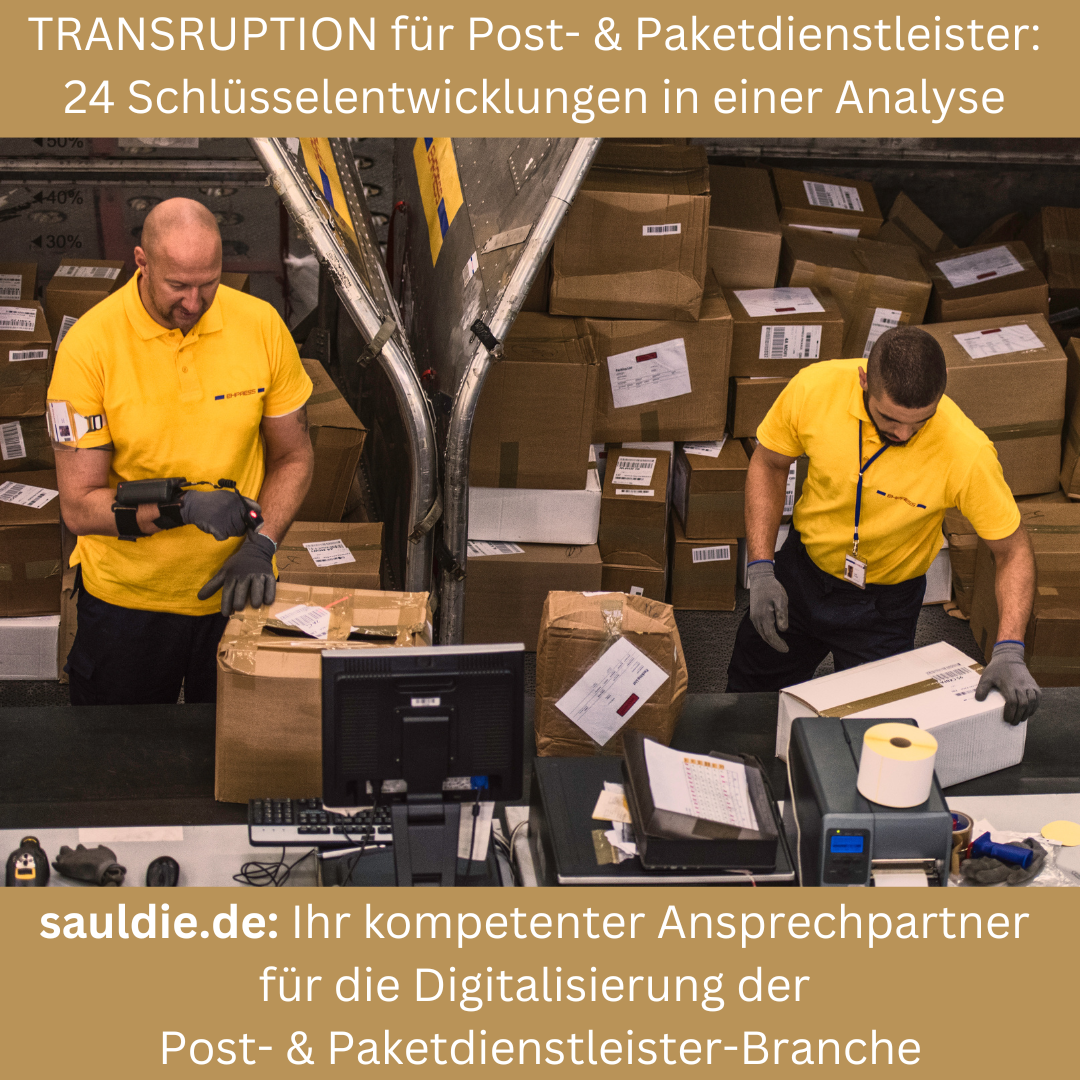The postal and parcel services industry is facing a digital revolution. With the growing eCommerce sector, changing customer behaviour and technological advancements, it is vital that companies in this industry adopt the right strategies and technologies to remain competitive and transform their business models. The TRANSRUPTION strategy brings together 24 important key technologies that are specifically tailored to the needs of postal and parcel service providers.
The importance of 24 technologies for the postal and parcel services industry:
The 24 technologies, including 3D printing, automation, big data-smart data, blockchain, digital transformation, artificial intelligence and many more, offer a wide range of opportunities for decision-makers in the postal and parcel services industry. They enable companies to introduce more efficient and customer-centred processes, improve the quality of services and offer innovative solutions. From optimising the supply chain to personnel management and improving the customer experience, there are numerous fields of application for these technologies.
In the future, postal and parcel services will continue to develop and gain in importance. The increasing demand for online shopping and fast deliveries requires innovative solutions and adaptability on the part of companies. The integration of technologies such as the Internet of Things, artificial intelligence and robotics will increase efficiency and accuracy in delivery. In addition, sustainable practices and environmental awareness are becoming increasingly important in order to minimise the ecological footprint.
The TRANSRUPTION strategy offers decision-makers in the postal and parcel services industry a comprehensive solution for tackling the challenges of the future and utilising the opportunities presented by technology. By integrating these technologies into their business models and optimising their processes, companies in this sector can strengthen their competitiveness and move successfully into the future.
The transformation of the postal and parcel service provider industry will be significantly characterised by the 24 technologies of the TRANSRUPTION strategy. These technologies will help to make the entire operation more efficient, faster and safer. Through the use of automation and robotics, processes such as sorting, packaging and delivery can be optimised, leading to an increase in efficiency and productivity.
The use of big data and smart data enables better analysis and forecasting of shipment volumes, which in turn leads to optimised resource planning and improved customer satisfaction. Blockchain technology offers transparency and security in the supply chain by making the entire shipment process traceable and minimising fraud.
The integration of artificial intelligence and machine learning enables personalised customer communication, automated customer support systems and precise delivery forecasts. This enables postal and parcel service providers to tailor their services to the individual needs of their customers while improving the efficiency and accuracy of their processes.
The ongoing development of technologies such as the Internet of Things, virtual and augmented reality and drone technology opens up new possibilities for delivery and logistics. By using smart devices, virtual simulations and innovative delivery methods, postal and parcel service providers can extend their reach, shorten delivery times and offer a better quality of service.
Technologies |
Opportunities for the postal and parcel services sector |
|---|---|
The postal and parcel services industry can benefit from 3D printing by offering innovative solutions such as personalised products, rapid prototyping and efficient spare parts production. This enables shorter delivery times, reduces warehousing costs and increases customer satisfaction. |
|
Automation technology enables postal and parcel service providers to optimise their operations by automating sorting, packaging and delivery. This enables them to increase efficiency, reduce costs and ensure faster and more precise processing of consignments. |
|
By utilising big data and smart data, postal and parcel service providers can gain valuable insights into customer preferences, delivery patterns and efficiency gains. Analysing large volumes of data enables optimised route planning, forecasts for shipment volumes and improved resource allocation. |
|
The integration of blockchain technology enables postal and parcel service providers to track consignments transparently and securely in real time. Thanks to decentralised data storage and the ability to verify transactions, they can improve the security and reliability of their services. |
|
The postal and parcel services industry can use crowdfunding platforms to attract investment for innovative projects and the further development of their services. Financing options 4.0 offer access to alternative sources of capital that do not even require the crowdfunding sum to be returned. |
|
The postal and parcel services industry can use crowdfunding platforms to attract investment for innovative projects and the further development of their services. Financing 4.0 offers access to alternative sources of capital, while the integration of blockchain technology increases the security and transparency of financial transactions. |
|
Postal and parcel service providers can benefit from modern security solutions to protect themselves against cyberattacks and data breaches. By using AI-based security measures and preventative measures, they can ensure the confidentiality, integrity and availability of their systems and data. |
|
Digital branding enables postal and parcel service providers to increase their brand awareness and build a strong online presence. With a targeted brand strategy and appealing digital content, they can gain the trust of customers, strengthen customer loyalty and successfully differentiate their services. |
|
Postal and parcel service providers can benefit from strong digital leadership in order to successfully manage the digital transformation. Digital leaders promote a culture of innovation, agile working and digital skills within the company, which leads to the effective implementation of new technologies and a high level of adaptability. |
|
Digital disruption offers postal and parcel service providers the opportunity to rethink traditional business models and offer innovative solutions. By introducing new technologies and business practices, they can protect themselves from new competitors, e.g. start-ups. |
|
Postal and parcel service providers can use the opportunities presented by the digital society to open up new communication channels, strengthen customer dialogue and offer innovative services. By actively participating in the digital transformation, they can keep pace with customers' needs and expectations. |
|
By integrating into digital marketplaces, postal and parcel service providers can expand their reach and gain new customers. By offering their services on established platforms, they can increase visibility, build trust and ensure efficient delivery processes. |
|
The digital transformation enables postal and parcel service providers to modernise their business models and processes. By using technologies such as automation, artificial intelligence and IoT, they can realise more efficient and agile operational processes and offer innovative services. |
|
Digital marketing offers postal and parcel service providers a wide range of opportunities to reach their target group and advertise their services. Through personalised advertising campaigns, social media marketing and targeted customer communication, they can increase brand awareness, acquire new customers and strengthen customer loyalty. |
|
A sound knowledge of digital law helps postal and parcel service providers to overcome legal challenges in the digital environment. By complying with data protection regulations, electronic signatures and contract law, they can minimise legal risks and strengthen customer trust. |
|
Postal and parcel service providers can use drone technology to make fast and efficient deliveries to remote areas or densely populated cities. By using drones, they can shorten delivery times and reduce ground transport costs. |
|
eCommerce offers postal and parcel service providers the opportunity to offer their services online and reach customers in digital commerce. By offering seamless ordering and delivery processes, they can improve the customer experience and increase competitiveness. |
|
Postal and parcel service providers can benefit from the possibilities of HR, Work and Teams 4.0 by using digital tools and technologies for employee management, collaboration and training. This enables them to create efficient work processes, increase employee satisfaction and attract qualified staff. |
|
By implementing Industry and Factory 4.0 technologies, postal and parcel service providers can automate their production processes, collect and analyse data in real time and increase the efficiency of their operations. This enables them to reduce costs and improve product quality. |
|
The Internet of Things offers postal and parcel service providers the opportunity to monitor shipments and fleets in real time, automatically manage stock levels and optimise delivery. By networking devices, they can increase efficiency and shorten delivery times. |
|
The use of artificial intelligence enables postal and parcel service providers to develop forecasting models for demand and deliveries, automate customer support and use route optimisation algorithms. This enables them to reduce costs, increase efficiency and offer personalised customer service. |
|
Sustainability and environmental awareness are of great importance to postal and parcel service providers. By using environmentally friendly vehicles, optimising route planning and reducing packaging materials, they can reduce their ecological footprint and at the same time increase customer awareness of green services. |
|
Nanotechnology offers postal and parcel service providers the opportunity to use high-precision sensors and tags to monitor shipments in real time and improve quality assurance. By using nanomaterials, they can also develop lighter and more resistant packaging to minimise transport damage. |
|
Postal and parcel service providers can use robots for automated tasks such as sorting, packaging and warehouse management. By using robotic technology, they can increase efficiency, improve accuracy and reduce manual labour costs. |
|
Postal and parcel service providers can use virtual and augmented reality to provide training for employees, visualise complex logistical processes and improve the efficiency of packaging and shipping processes. This enables them to reduce training costs and increase the quality of work processes. |
To summarise, the TRANSRUPTION strategy will help decision-makers in the postal and parcel service provider sector to make the most of the opportunities offered by technology and make their companies fit for the future. Through the targeted integration and application of the 24 key technologies, they can optimise their business processes, increase customer satisfaction and position themselves as innovative and efficient providers. The future of the industry lies in the intelligent utilisation of these technologies in order to meet the changing demands of the market and secure a competitive advantage.















